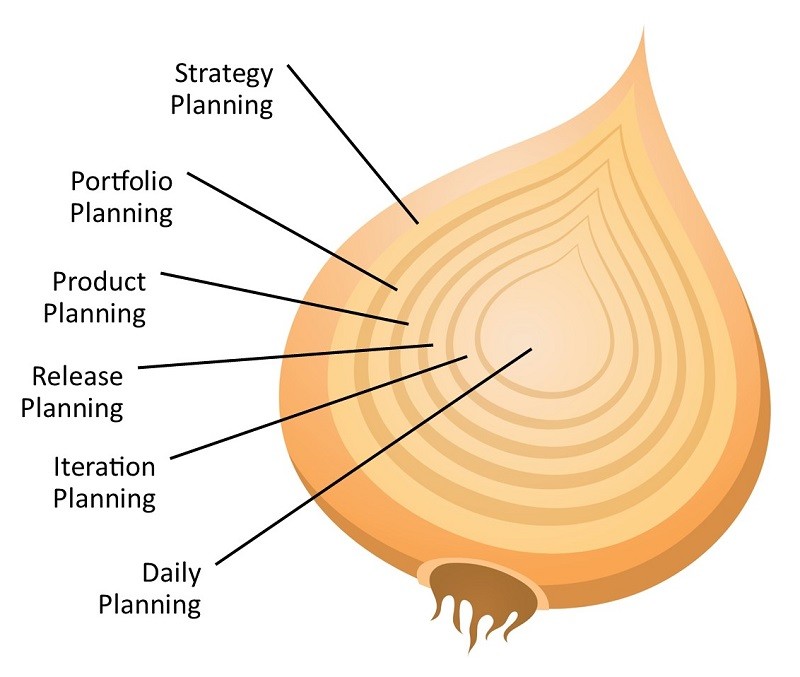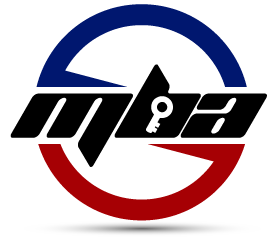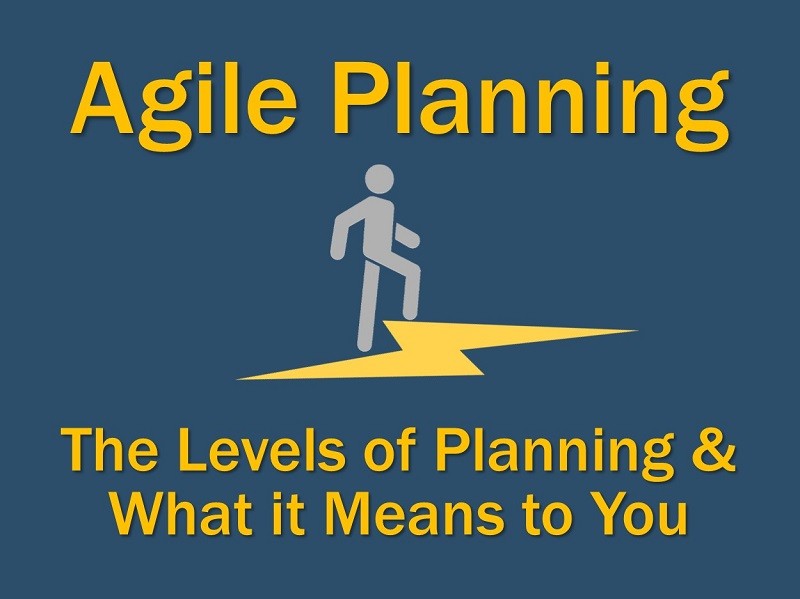Understanding the different levels of Agile planning and what they mean for you will help your team stay aligned and focused on achieving the right outcomes.
Show Notes
Responding to change over following a plan. This value listed in the Agile Manifesto doesn’t mean that we don’t do planning in Agile. In fact, we plan more in Agile than in traditional methods; we just do it differently.
A common metaphor for planning in Agile is an onion. Each layer of the onion reflects another level of planning – from strategic to tactical.
Let’s take a look at each of these layers and what it means to you.

Strategic Planning
The outermost layer of the Agile planning onion is the strategic level. At the strategic level of planning, organizations set their direction. It involves the mission and vision as well as long-term goals. This is multi-year planning.
If you’re a Product Manager, Business Architect, or in another strategic role, you might provide input into the strategic plan by helping organizational leaders understand where the market is going and your organization’s capabilities. Common tools are SWOT Analysis and PEST or PESTLE Analysis.
Portfolio Planning
The next layer of the planning onion is the Portfolio level. This is where the organization decides what products or initiatives to work on. This is essentially where and how much the organization will invest.
We can support this level of planning by providing input through business cases, business models, and other approaches. You may also be involved in the ideation of new products or new initiatives. In some cases, you may even recommend that certain initiatives be stopped due to changing market conditions or changing customer needs.
Once portfolio planning is complete, the plan should serve as an input as to where we should focus effort and resources.
Product Planning
The next layer is Product planning. At this level, we determine the goals and objectives of the product and how we’ll achieve those outcomes. You’ll likely develop Objectives and Key Results (OKRs) for the product as well as a product roadmap.
This level of planning provides context to the teams working on the product and is usually developed by a Product Manager in collaboration with stakeholders and subject matter experts.
Remember that an Agile Roadmap isn’t just a Gannt Chart showing timing or different initiatives. A good roadmap is outcome based and may include options to achieve those outcomes as well as certain milestones such as a contractual or compliance required date. Your roadmap should also allow you to respond to changing market conditions.
During Product Planning, you’ll also define the Product Goal and start building and ordering your product backlog.
The innermost planning levels of release, iteration, and daily are considered team level planning.
Release Planning
At the Release level of planning, the team plans for the next major release. Even if you deploy continuously, this level of planning looks at the next coherent set of features or pieces of functionality.
This is often where you may define the Minimum Viable Product (MVP) or Minimum Marketable Features (MMF).
Depending on your organization, at this level you might break down Epics into Features or help the team determine what can be achieved in the release. In some Agile scaling frameworks, a Feature is a larger set of work that can be completed within the release time box.
You’ll also want to start breaking down the higher priority features into User Stories or other backlog items.
Iteration Planning
The next layer of the Agile planning onion is Iteration planning. If you’re using an iterative approach, this is where you plan for the next iteration or time box. In Scrum, this is known as Sprint Planning.
If you’re a Product Owner or Business Analyst on an Agile team, you’ll need to get the User Stories and other backlog items to a ready state. This means they’re small, testable, well understood by the team, and meet the other definition of ready criteria.
You might also be involved in helping the team refine and size the product backlog items prior to iteration planning. This helps ensure the team can properly forecast what they can complete in the iteration.
If you use Scrum, you’ll define a Sprint Goal with the team as part of Sprint Planning. The Sprint Goal helps bring focus and alignment to the Scrum Team and encourages them to work together as a team rather than individuals.
Daily Planning
The final and innermost layer of the Agile planning onion is Daily planning. On a daily bases, team members get together to discuss the progress they’ve made, where they need help, and what they’ll do next taking any needed adjustments into account.
If you’re on a Scrum Team, this is the Daily Scrum. Many teams make the mistake of turning the Daily Scrum into a status meeting. It’s actually a quick planning meeting that creates transparency into where we are and allows us to inspect progress and adjust.
If you’re a Product Owner, Business Analyst, or someone else not working on the tasks associated with completing the work planned for the iteration, daily planning or the Daily Scrum is an opportunity to help the team adjust plans and remove impediments that are slowing down or stopping the team’s progress. You can also clarify any misunderstandings about the details or intent of the backlog items.
Understanding the different layers of the Agile planning onion and the different levels of planning will help you and your team stay aligned and focus on the right things.
Listen to the full episode to better understand the different levels of planning in Agile.

Thank you for listening to the program
To get more valuable content to enhance your skills and advance your career, you can subscribe on iTunes.
Also, reviews on iTunes are highly appreciated! I read each review and it helps keep me motivated to continue to bring you valuable content each week.



